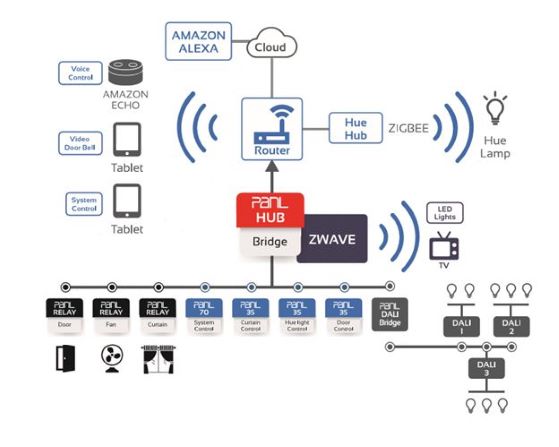By Gavin Moore, Customer Engineering Support Manager, Bridgetek
Bringing automation into the domestic environment has been talked about extensively over the last twenty years, yet, full-scale adoption has been surprisingly slow. There are several reasons for this: The hardware was initially too expensive, followed by the inconvenience of installing all the cabling. There was also a limited number of electricians with the necessary skillset to carry out this type of work.
Fortunately, over time, most of these issues faded away. The cost of electronics (sensors, actuators, etc.) steadily decreased and is no longer a barrier. Further, the widespread implementation of wireless communication helped dispense of wireline connectivity, making home automation more convenient and cheaper to install. The only difficulty that remains now is one of integration – the industry needs a way to make various different smart technologies in the home automation system work harmoniously for the end user, which, to date, has proven elusive.
The market’s fragmented nature has prevented this integration, with lighting and heating companies developing their own proprietary systems, with little provision for interoperability. Hence, installations have comprised of many disparate, isolated subsystems for heating, lighting, security, etc, from different suppliers. Each of these subsystems uses its own control mechanism of various degrees of sophistication that the user must access through a separate human machine interface (HMI), which leaves the whole smart-home experience unsatisfactory and consumers disappointed.
When it comes to the command of electronics systems, the smartphone has significantly raised the bar, and now everyone expects intuitive and seamless operations.
Innovation Starts at Home
There’s no doubt that the labour-saving benefits of home automation are fuelling public interest. Smarter living will also reduce energy consumption and pollution levels, helping protect the environment. Also, with an ageing population, there are countless possibilities via which home automation technology can lead to quality-of-life improvements.
Focusing on a centralised architecture with a consistent HMI style will prove beneficial to end users and, hence, the adoption of home automation. The challenge so far has been in bridging the communication protocols used by different subsystems and creating an interoperable platform.

Figure 1: Schematic of the PanL Smart Living Solution
The engineering team at Bridgetek is tackling integration by developing a specific HMI solution, called PanL. The platform allows direct control of lighting, air conditioning, heating and security systems, and enables functionality upgrades of domestic appliances. PanL does away with separate apps or control units for each of these systems, offering only one touch-enabled HMI for everything, which can also be voice-activated; see Figure 1. Moreover, with this approach, systems can be coordinated with one another; for example, lighting and heating can be scheduled to come on at the same time, or a security system activated once the doors are locked and lights are out.
Figure 1 shows PanL Hub at the centre of the home automation arrangement. It interfaces with a diverse range of hardware through an array of wireless and wired connectivity options, including RS485, Wi-Fi (802.11 b/g/n), Z-Wave, Zigbee, Bluetooth Low Energy (BLE) and Ethernet (including PoE), and proprietary protocols like DALI and Philips Hue lighting. Accessories like lighting- and relay controllers can be programmed to switch on and off AC or DC loads such as fans for air conditioning, motors for closing/opening curtains, or magnetic actuators for locking/unlocking doors. There are two display unit models, a compact 3.5-inch 320×480-pixel resolution PanL35 and a larger, 7-inch 800×480-pixel resolution PanL70. An Amazon Voice Service has been integrated into this system as an alternative to the touch units, so users can activate different functions through an Alexa-controlled Echo smart speaker.
Beyond the Domestic Environment
There are countless possibilities outside the home where similar installations could be equally advantageous: healthcare, agriculture, retail and utilities sectors are just a few. In an office, the PanL Room Manager is a more befitting option, since it is an intelligent meeting-room booking system that, much in the same way as the home automation solution, comprises a hub and suitable accessories, such as HMI units with built-in RFID transceivers located outside each meeting room. The RFID technology allows access to authorised personnel when encountering their badges which integrate an RFID tag.

Figure 2: Schematic of the PanL Room Manager Solution
HMI Complexities
It has taken a long time for smart home technology to happen, mostly because of the market politics involved. Increasing prevalence of automated systems for domestic environments will be more forthcoming if the user experience is made easier and more intuitive, and the unnecessary HMI complexities eliminated, but this technology is finally gathering pace.










